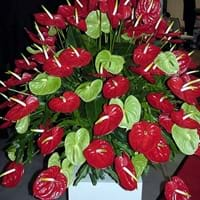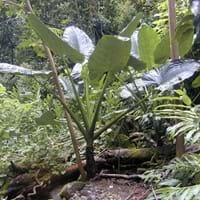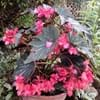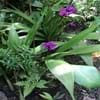Life Span
Annual and Perennial
Perennial
Type
Tender Perennial
Tender Perennial
Origin
Central America, South America
Southeastern Asia
Types
not available
Taro Alocasia reginula, Night scented lily
Habitat
Humid climates, Tropical Forests
Terrestrial, Wet lands
USDA Hardiness Zone
10-11
10-15
Sunset Zone
H2
H1, H2, 22, 23, 24
Habit
Clump-Forming
Cushion/Mound-forming
Flower Color
Yellow, Red, Orange Red
White
Flower Color Modifier
Bicolor
Not Available
Fruit Color
Not Available
Not Available
Leaf Color in Spring
Green, Light Green
Purple, Dark Green, Silver, Black
Leaf Color in Summer
Green, Light Green
Purple, Dark Green, Silver, Black
Leaf Color in Fall
Green, Light Green
Purple, Dark Green, Silver, Black
Leaf Color in Winter
Green, Light Green
Green, Dark Green, Silver, Black
Leaf Shape
Oblong
Heart-shaped
Plant Season
Spring, Summer, Fall, Winter
Spring, Summer, Fall, Winter
Sunlight
Partial Sun, Partial shade
Full Sun, Partial Sun, Partial shade, Full Shade
The pH of Soil
Neutral
Acidic, Neutral, Alkaline
Soil Drainage
Well drained
Well drained
Bloom Time
Indeterminate
Indeterminate
Tolerances
Drought
Full Sun, Humidity
Where to Plant?
Container, Ground, Pot
Container, Ground, Pot
How to Plant?
Seedlings, Vegetative
Divison, From bulbs, From Rhizomes
Plant Maintenance
Medium
Low
Watering Requirements
Keep ground moist, Keep the Soil well drained, Requires regular watering
Average Water Needs, Do Not over Water, Never Over-water, Water Deeply
In Summer
Lots of watering
Lots of watering
In Spring
Moderate
Average Water
In Winter
Average Water
Less Watering
Soil pH
Neutral
Acidic, Neutral, Alkaline
Soil Drainage Capacity
Well drained
Well drained
Sun Exposure
Partial Sun, Partial shade
Full Sun, Partial Sun, Partial shade, Full Shade
Pruning
Remove damaged leaves, Remove dead branches, Remove dead leaves
Prune to stimulate growth, Remove damaged leaves, Remove dead leaves, Remove deadheads
Fertilizers
All-Purpose Liquid Fertilizer
All-Purpose Liquid Fertilizer, Nitrogen, Phosphorous, Potassium
Pests and Diseases
Mealy bugs, Mites, Nematodes, Scale
Blight, Mites, Red spider mite
Plant Tolerance
Drought
Full Sun, Humidity
Flowers
Showy
Insignificant
Flower Petal Number
Single
Single
Foliage Texture
Coarse
Medium
Foliage Sheen
Glossy
Matte
Attracts
Flies, Flying insects, Insects, Not Available
Spider Mites
Aesthetic Uses
along a porch, deck or patio, Borders, Decorating walls, Hanging Basket, Used for decorating walls, fences, gates, hedges, etc.
Beautification, Showy Purposes
Beauty Benefits
Not Available
No Beauty Benefits
Environmental Uses
Air purification
Air purification, Food for insects
Medicinal Uses
Boils, Rheumatism
No Medicinal Use
Part of Plant Used
Flowers, Shoots
Not Available
Other Uses
Used as Ornamental plant, Used for its medicinal properties, Used for Landscaping
Air freshner, Decoration Purposes, Showy Purposes, Used as Ornamental plant
Used As Indoor Plant
Sometimes
Yes
Used As Outdoor Plant
Yes
Yes
Garden Design
Bedding Plant, Container, Cutflower, Foundation, Houseplant, Tropical
Bedding Plant, Container, Feature Plant, Houseplant, Mixed Border, Tropical
Botanical Name
ANTHURIUM andraeanum
ALOCASIA reginula
Common Name
Flamingo Lily, Oil Cloth Flower, Oilcloth Flower, Tail Flower, Tailflower
Elephant Ear
In Hindi
tail flower
Elephant Ear
In German
Schwanz Blume
Elephant Ear
In French
Anthurium andraeanum
Elephant Ear
In Spanish
tail flower
Elephant Ear
In Greek
Tail flower
Elephant Ear
In Portuguese
Tailflower
Elephant Ear
In Polish
Anturium Andrego
Elephant Ear
In Latin
Tail flower
Elephant Ear
Phylum
Tracheophyta
Magnoliophyta
Class
Liliopsida
Liliopsida
Order
Solanales
Alismatales
Genus
Anthocercis
Alocasia
Clade
Angiosperms, Asterids, Eudicots
Angiosperms, Monocots
Tribe
Anthurieae
Colocasiodeae
Subfamily
Not Available, Pothoideae
Aroideae
Importance of Tail Flower and Elephant Ear
Want to have the most appropriate plant for your garden? You might want to know the importance of Tail Flower and Elephant Ear. Basically, these two plants vary in many aspects. Compare Tail Flower and Elephant Ear as they differ in many characteristics such as their life, care, benefits, facts, etc. Every gardener must at least have the slightest clue about the plants he wants to plant in his garden. Compare their benefits, which differ in many ways like facts and uses. The medicinal use of Tail Flower is Boils and Rheumatism whereas of Elephant Ear is No Medicinal Use. Tail Flower has beauty benefits as follows: Not Available while Elephant Ear has beauty benefits as follows: Not Available.
Compare Facts of Tail Flower vs Elephant Ear
How to choose the best garden plant for your garden depending upon its facts? Here garden plant comparison will help you to solve this query. Compare the facts of Tail Flower vs Elephant Ear and know which one to choose. As garden plants have benefits and other uses, allergy is also a major drawback of plants for some people. Allergic reactions of Tail Flower are Toxic whereas of Elephant Ear have Toxic respectively. Having a fruit bearing plant in your garden can be a plus point of your garden. Tail Flower has no showy fruits and Elephant Ear has no showy fruits. Also Tail Flower is not flowering and Elephant Ear is not flowering . You can compare Tail Flower and Elephant Ear facts and facts of other plants too.





